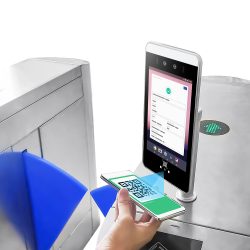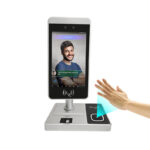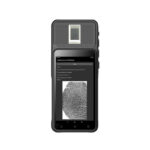This is the heading
What is a QR Code?
A QR code is a two-dimensional matrix barcode capable of storing information in a pattern of black and white squares. These codes can encode text, numeric data, URLs, or encrypted authentication credentials, making them versatile for various applications in biometric systems.

Key Features of QR Codes
QR codes offer a variety of features that make them highly effective in biometric devices, access control systems, and attendance management solutions. Here are the main features in detail:
1. Fast and Accurate Scanning
QR codes can be scanned almost instantly using biometric scanners, mobile devices, or integrated access terminals.
This ensures quick authentication in high-traffic areas such as offices, schools, or event venues, improving efficiency and user experience.
2. High Data Capacity
QR codes can store large amounts of information, including user IDs, encrypted credentials, URLs, or access permissions.
This makes them ideal for linking biometric profiles to digital records and managing secure access or attendance data.
3. Error Correction and Reliability
QR codes include built-in error correction, allowing them to be scanned accurately even if partially damaged or obscured.
Ensures reliability in real-world scenarios, such as outdoor access points, factories, or public facilities.
4. Dynamic and Secure Integration
QR codes can be dynamic, allowing temporary access permissions or guest authentication, and can be encrypted for added security.
When combined with biometric verification like fingerprint, facial, or palm vein recognition, they create a multi-factor authentication system.
5. Versatility and Ease of Use
QR codes are easy to generate, integrate, and customize, supporting various applications in attendance management, access control, mobile authentication, and payment systems.
Their cross-platform compatibility ensures seamless use across smartphones, tablets, and biometric devices.
How QR Codes Work in Biometric Devices
QR codes are increasingly used in biometric devices to enhance authentication accuracy and user convenience. They work in combination with biometric verification to ensure a secure, efficient, and seamless user experience.
1. Related videos
2. User Enrollment
During user registration, a unique QR code is generated and linked to the user’s biometric data. This process simplifies identification and ensures that biometric profiles are securely associated with the correct individual.
3. Authentication
When accessing a facility or checking in for attendance, the user can scan their QR code. The biometric device then cross-verifies the QR code data with stored fingerprint, facial, or palm vein data for a fast and secure authentication process.
4. Access Control
QR codes in access control systems allow organizations to manage temporary or permanent permissions. This is particularly useful for guest access, restricted areas, or time-limited events, ensuring secure and flexible control.
5. Attendance Management
In workplaces, schools, and public facilities, QR codes simplify the process of tracking check-ins and check-outs. When integrated with attendance management software like HFIMS, QR codes enable real-time reporting, automated record-keeping, and data analytics for improved operational efficiency.
Benefits of Using QR Codes in Biometric Systems
Integrating QR codes with biometric devices offers numerous advantages for organizations seeking secure and efficient identity verification.
Enhanced Security: Combining QR codes with biometric authentication reduces risks of identity fraud and unauthorized access.
Faster Operations: Users can gain access or check-in quickly, minimizing queues and improving workplace efficiency.
Cost Efficiency: QR codes can replace traditional physical cards or tokens, reducing operational costs.
Remote Access and Mobile Integration: QR codes can be scanned via smartphones, enabling mobile authentication and remote management.
Flexibility: Ideal for temporary employees, contractors, or visitors, providing dynamic access rights without hardware changes.
Applications Across Industries
QR codes in biometric systems have widespread applications across various sectors:
1. Corporate Offices
Used for employee attendance and secure building access, QR codes ensure that only authorized personnel can enter restricted areas.
2. Healthcare
QR codes help identify patients, track medical records, and control access to sensitive areas, integrating with biometric scanners for enhanced security.
3. Education
Schools and universities use QR codes to monitor student attendance, manage access to laboratories and libraries, and improve operational efficiency.
4. Events and Conferences
QR codes provide quick check-ins, ticket verification, and secure attendee management, ensuring smooth event operations.
5. Retail and Payment Systems
QR codes can also integrate with biometric POS machines, allowing secure and fast payments with combined QR scanning and biometric verification.
Tendances futures
As biometric technology continues to evolve, the role of QR codes will expand significantly. Key trends include:
Dynamic QR Codes: Regularly changing codes with enhanced encryption for improved security.
Multi-Factor Authentication: QR codes combined with biometric verification and PIN codes for higher protection.
Mobile Integration: Smartphones acting as both QR code generators and scanners for seamless authentication.
AI-Powered Analytics: QR codes integrated with biometric devices and AI systems for predictive analytics, fraud detection, and operational optimization.
Related products
Conclusion
Understanding what QR code means in biometric devices is critical for organizations aiming to enhance security, efficiency, and user experience. By combining QR codes with fingerprint, facial, and palm vein recognition, businesses can achieve a highly secure, flexible, and cost-effective access control and attendance system. QR codes are no longer just a convenience—they are a vital component of modern biometric security systems, enabling rapid authentication, accurate identity verification, and seamless management across multiple industries.
Contactez-nous
We would love to speak with you.
Feel free to reach out using the below details.





